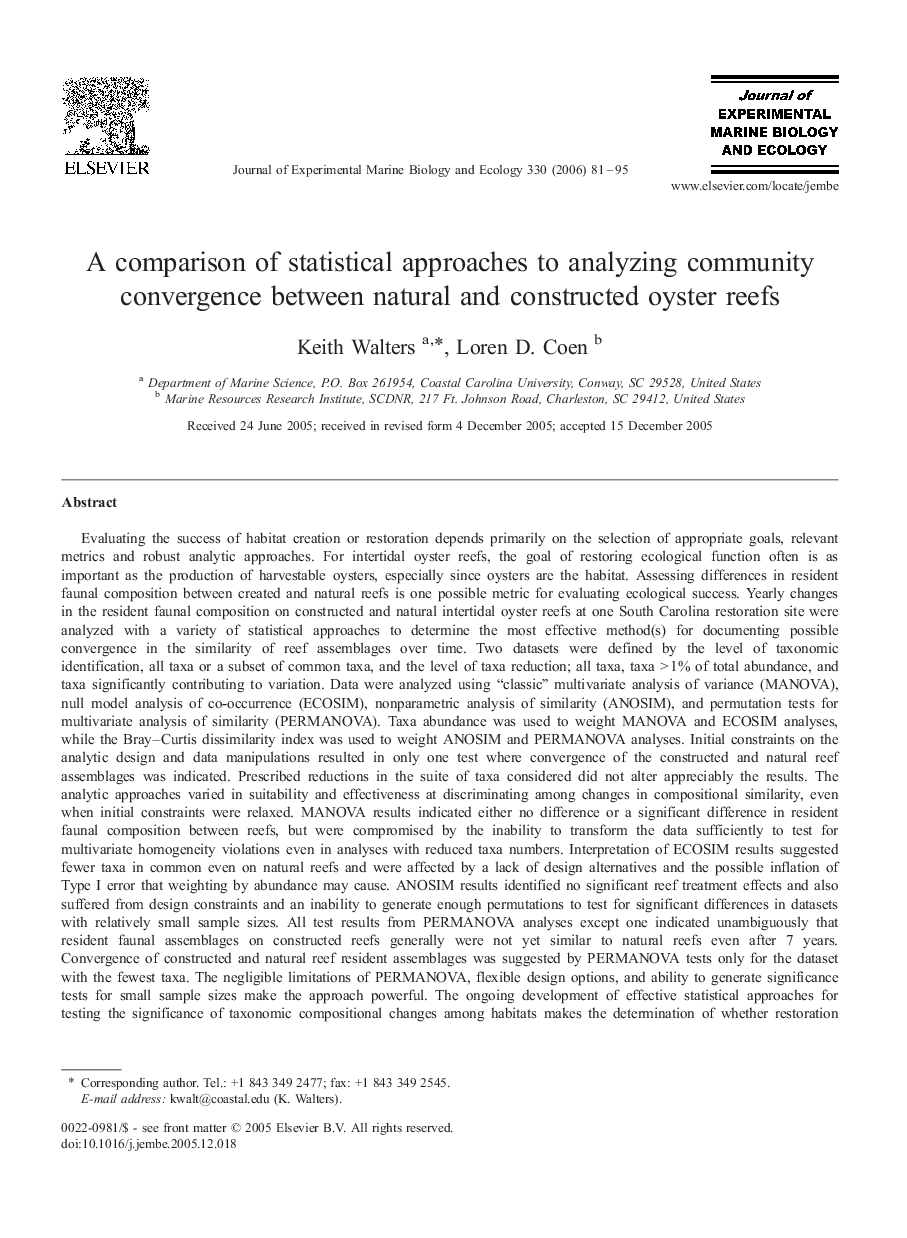| کد مقاله | کد نشریه | سال انتشار | مقاله انگلیسی | نسخه تمام متن |
|---|---|---|---|---|
| 4398209 | 1305932 | 2006 | 15 صفحه PDF | دانلود رایگان |

Evaluating the success of habitat creation or restoration depends primarily on the selection of appropriate goals, relevant metrics and robust analytic approaches. For intertidal oyster reefs, the goal of restoring ecological function often is as important as the production of harvestable oysters, especially since oysters are the habitat. Assessing differences in resident faunal composition between created and natural reefs is one possible metric for evaluating ecological success. Yearly changes in the resident faunal composition on constructed and natural intertidal oyster reefs at one South Carolina restoration site were analyzed with a variety of statistical approaches to determine the most effective method(s) for documenting possible convergence in the similarity of reef assemblages over time. Two datasets were defined by the level of taxonomic identification, all taxa or a subset of common taxa, and the level of taxa reduction; all taxa, taxa > 1% of total abundance, and taxa significantly contributing to variation. Data were analyzed using “classic” multivariate analysis of variance (MANOVA), null model analysis of co-occurrence (ECOSIM), nonparametric analysis of similarity (ANOSIM), and permutation tests for multivariate analysis of similarity (PERMANOVA). Taxa abundance was used to weight MANOVA and ECOSIM analyses, while the Bray–Curtis dissimilarity index was used to weight ANOSIM and PERMANOVA analyses. Initial constraints on the analytic design and data manipulations resulted in only one test where convergence of the constructed and natural reef assemblages was indicated. Prescribed reductions in the suite of taxa considered did not alter appreciably the results. The analytic approaches varied in suitability and effectiveness at discriminating among changes in compositional similarity, even when initial constraints were relaxed. MANOVA results indicated either no difference or a significant difference in resident faunal composition between reefs, but were compromised by the inability to transform the data sufficiently to test for multivariate homogeneity violations even in analyses with reduced taxa numbers. Interpretation of ECOSIM results suggested fewer taxa in common even on natural reefs and were affected by a lack of design alternatives and the possible inflation of Type I error that weighting by abundance may cause. ANOSIM results identified no significant reef treatment effects and also suffered from design constraints and an inability to generate enough permutations to test for significant differences in datasets with relatively small sample sizes. All test results from PERMANOVA analyses except one indicated unambiguously that resident faunal assemblages on constructed reefs generally were not yet similar to natural reefs even after 7 years. Convergence of constructed and natural reef resident assemblages was suggested by PERMANOVA tests only for the dataset with the fewest taxa. The negligible limitations of PERMANOVA, flexible design options, and ability to generate significance tests for small sample sizes make the approach powerful. The ongoing development of effective statistical approaches for testing the significance of taxonomic compositional changes among habitats makes the determination of whether restoration projects are successful less dependent on the choice of analytic technique. More critical, biological questions including whether convergence of taxa abundance and composition is a valid indicator of similar ecological function remain to be answered.
Journal: Journal of Experimental Marine Biology and Ecology - Volume 330, Issue 1, 7 March 2006, Pages 81–95